Note
Access to this page requires authorization. You can try signing in or changing directories.
Access to this page requires authorization. You can try changing directories.
In the Sprint 160 Update of Azure DevOps, we added a new sprint burndown widget that supports burning down by story points, count of tasks and by summing custom fields. In addition, we improved pipelines security by restricting the scope of access tokens.
Check out the Features list below for more.
What’s new in Azure DevOps
Features
Azure Repos:
Azure Pipelines:
- Multi-stage pipelines UX
- Orchestrate canary deployment strategy on environment for Kubernetes
- Approval policies for YAML pipelines
- ACR as a first-class pipeline resource
- Pipeline resource meta-data as predefined variables
- Traceability for pipelines and ACR resources
- Simplified resource authorization in YAML pipelines
- Improve pipeline security by restricting the scope of access tokens
- Evaluate artifact check
- Markdown support in automated test error messages
- Diagnosing cron schedules in YAML
- Updates to the ARM template deployment task
- Project level security for service connections
- Ubuntu 18.04 pool
- Service Mesh Interface based canary deployments in KubernetesManifest task
- ReviewApp in Environment
Azure Artifacts:
- Updated Connect to feed experience
- Public feeds are now generally available with upstream support
- Create project-scoped feeds from the portal
Reporting:
Wiki:
Azure Repos
Cross-repo branch policy administration
Branch policies are one of the powerful features of Azure Repos that help you protect important branches. Although the ability to set policies at project level exists in the REST API, there was no user interface for it. Now, admins can set policies on a specific branch or the default branch across all repositories in their project. For example, an admin could require two minimum reviewers for all pull requests made into every main branch across every repository in their project. You can find the Add branch protection feature in the Repos Project Settings.
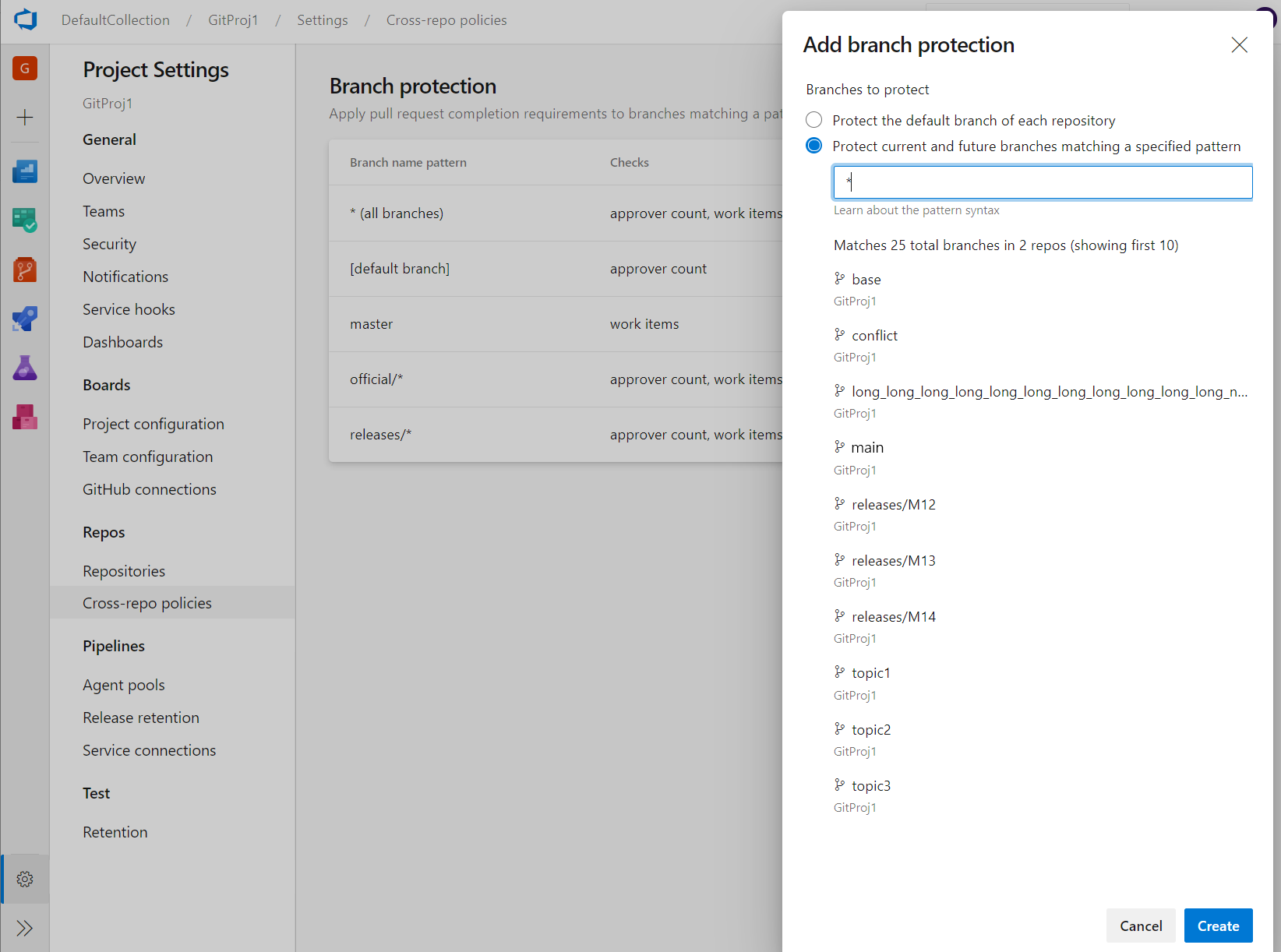
Azure Pipelines
Multi-stage pipelines UX
We've been working on an updated user experience to manage your pipelines. These updates make the pipelines experience modern and consistent with the direction of Azure DevOps. Moreover, these updates bring together classic build pipelines and multi-stage YAML pipelines into a single experience. For example, the following capabilities are included in the new experience; viewing and managing multiple stages, approving pipeline runs, ability to scroll all the way back in logs while a pipeline is still in progress, and per-branch health of a pipeline.
Thank you to all who have tried the new experience. If you haven't tried it, enable Multi-stage pipelines in the preview features. To learn more about multi-stage pipelines, see the documentation here .
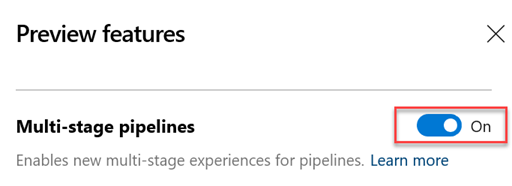
Thanks to your feedback, we addressed the following in the last two updates.
- Discoverability of folders view.
- Jumpiness in logs view.
- Readily show logs from previous and current tasks even when a run is in progress.
- Make it easier to navigate between tasks when reviewing logs.
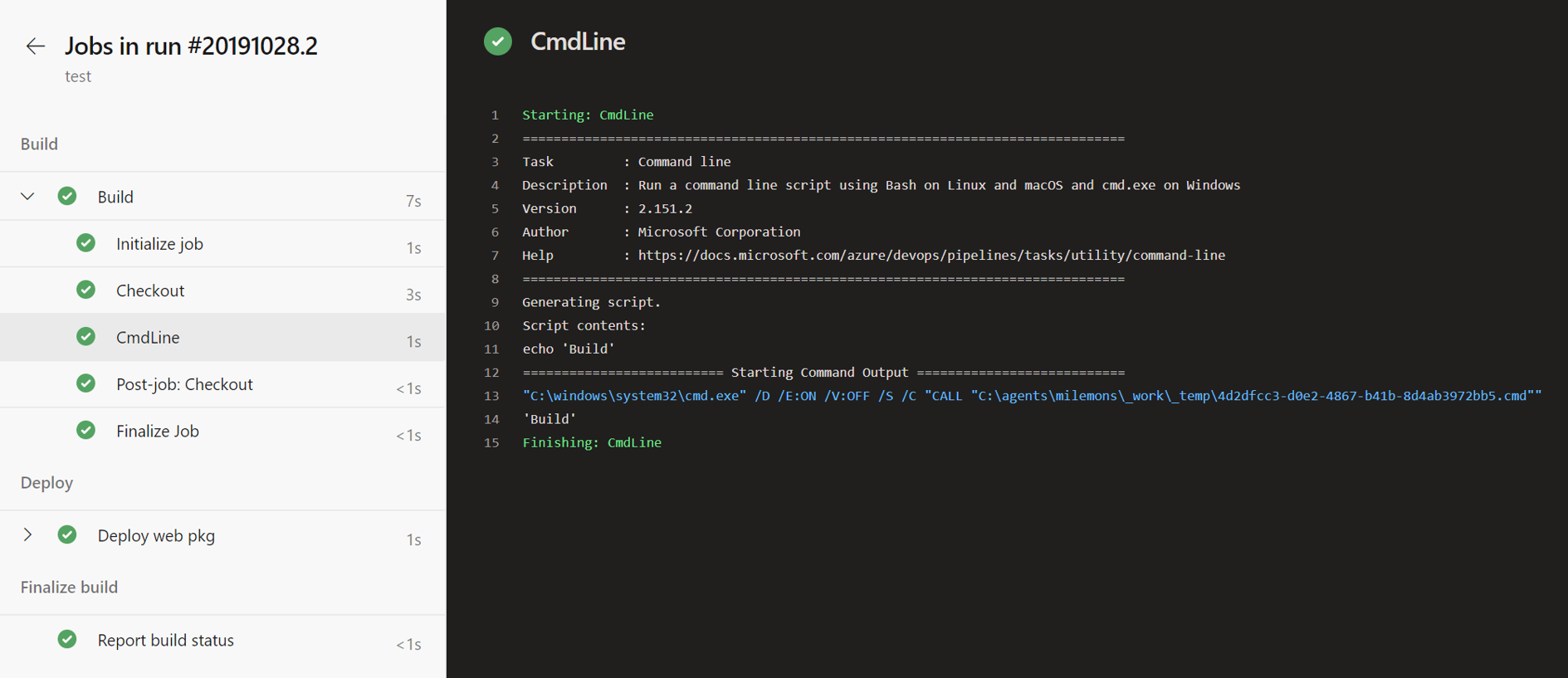
Note
In the next update, we plan to turn this feature on by default for everyone. You will still have the option to opt-out of the preview. A few weeks after that, the feature will be made generally available.
Orchestrate canary deployment strategy on environment for Kubernetes
One of the key advantages of continuous delivery of application updates is the ability to quickly push updates into production for specific microservices. This gives you the ability to quickly respond to changes in business requirements. Environment was introduced as a first-class concept enabling orchestration of deployment strategies and facilitating zero downtime releases. Previously, we supported the runOnce strategy which executed the steps once sequentially. With support for canary strategy in multi-stage pipelines, you can now reduce the risk by slowly rolling out the change to a small subset. As you gain more confidence in the new version, you can start rolling it out to more servers in your infrastructure and route more users to it.
jobs:
- deployment:
environment: musicCarnivalProd
pool:
name: musicCarnivalProdPool
strategy:
canary:
increments: [10,20]
preDeploy:
steps:
- script: initialize, cleanup....
deploy:
steps:
- script: echo deploy updates...
- task: KubernetesManifest@0
inputs:
action: $(strategy.action)
namespace: 'default'
strategy: $(strategy.name)
percentage: $(strategy.increment)
manifests: 'manifest.yml'
postRouteTraffic:
pool: server
steps:
- script: echo monitor application health...
on:
failure:
steps:
- script: echo clean-up, rollback...
success:
steps:
- script: echo checks passed, notify...
The canary strategy for Kubernetes will first deploy the changes with 10% pods followed by 20% while monitoring the health during postRouteTraffic. If all goes well, it will promote to 100%.
Approval policies for YAML pipelines
In YAML pipelines, we follow a resource owner-controlled approval configuration. Resource owners configure approvals on the resource and all pipelines that use the resource pause for approvals before start of the stage consuming the resource. It is common for SOX based application owners to restrict the requester of the deployment from approving their own deployments.
You can now use advanced approval options to configure approval policies like requester should not approve, require approval from a subset of users and approval timeout.
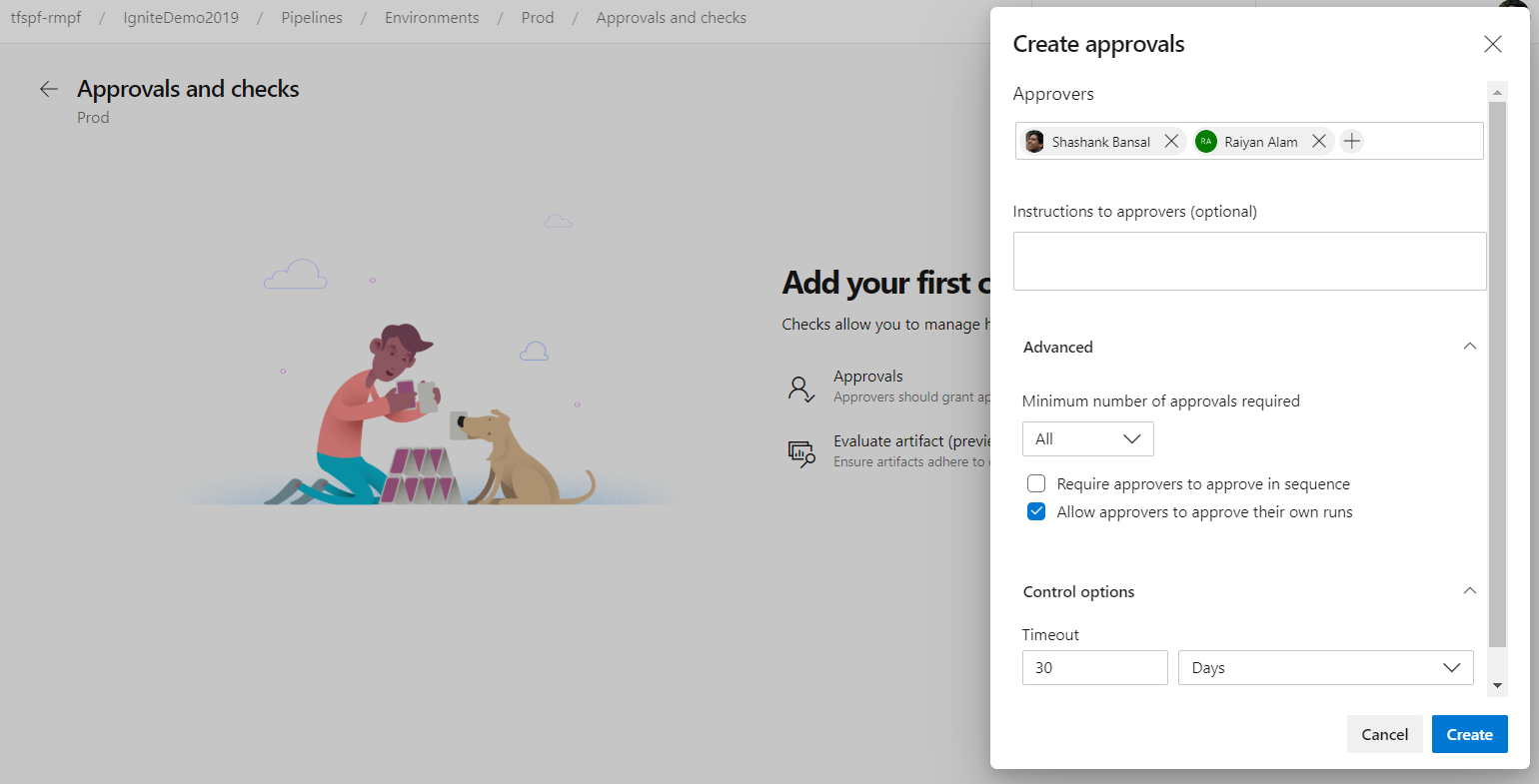
ACR as a first-class pipeline resource
If you need to consume a container image published to ACR (Azure Container Registry) as part of your pipeline and trigger your pipeline whenever a new image got published, you can use ACR container resource.
resources:
containers:
- container: MyACR #container resource alias
type: ACR
azureSubscription: RMPM #ARM service connection
resourceGroup: contosoRG
registry: contosodemo
repository: alphaworkz
trigger:
tags:
include:
- production
Moreover, ACR image meta-data can be accessed using predefined variables. The following list includes the ACR variables available to define an ACR container resource in your pipeline.
resources.container.<Alias>.type
resources.container.<Alias>.registry
resources.container.<Alias>.repository
resources.container.<Alias>.tag
resources.container.<Alias>.digest
resources.container.<Alias>.URI
resources.container.<Alias>.location
Pipeline resource meta-data as predefined variables
We've added predefined variables for YAML pipelines resources in the pipeline. Here is the list of the pipeline resource variables available.
resources.pipeline.<Alias>.projectName
resources.pipeline.<Alias>.projectID
resources.pipeline.<Alias>.pipelineName
resources.pipeline.<Alias>.pipelineID
resources.pipeline.<Alias>.runName
resources.pipeline.<Alias>.runID
resources.pipeline.<Alias>.runURI
resources.pipeline.<Alias>.sourceBranch
resources.pipeline.<Alias>.sourceCommit
resources.pipeline.<Alias>.sourceProvider
resources.pipeline.<Alias>.requestedFor
resources.pipeline.<Alias>.requestedForID
Traceability for pipelines and ACR resources
We ensure full E2E traceability when pipelines and ACR container resources are used in a pipeline. For every resource consumed by your YAML pipeline, you can trace back to the commits, work items and artifacts.
In the pipeline run summary view, you can see:
The resource version that triggered the run. Now, your pipeline can be triggered upon completion of another Azure pipeline run or when a container image is pushed to ACR.

The commits that are consumed by the pipeline. You can also find the breakdown of the commits by each resource consumed by the pipeline.
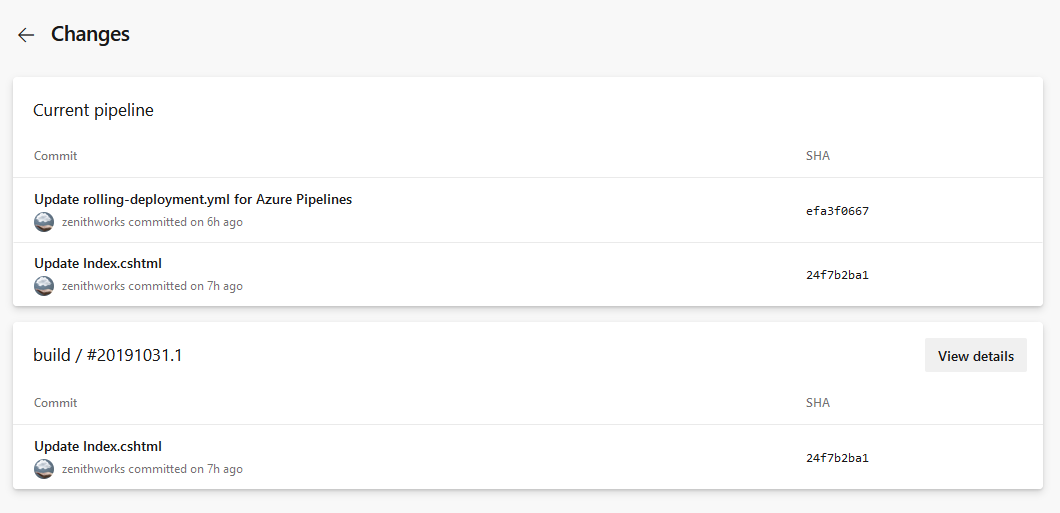
The work items that are associated with each resource consumed by the pipeline.
The artifacts that are available to be used by the run.
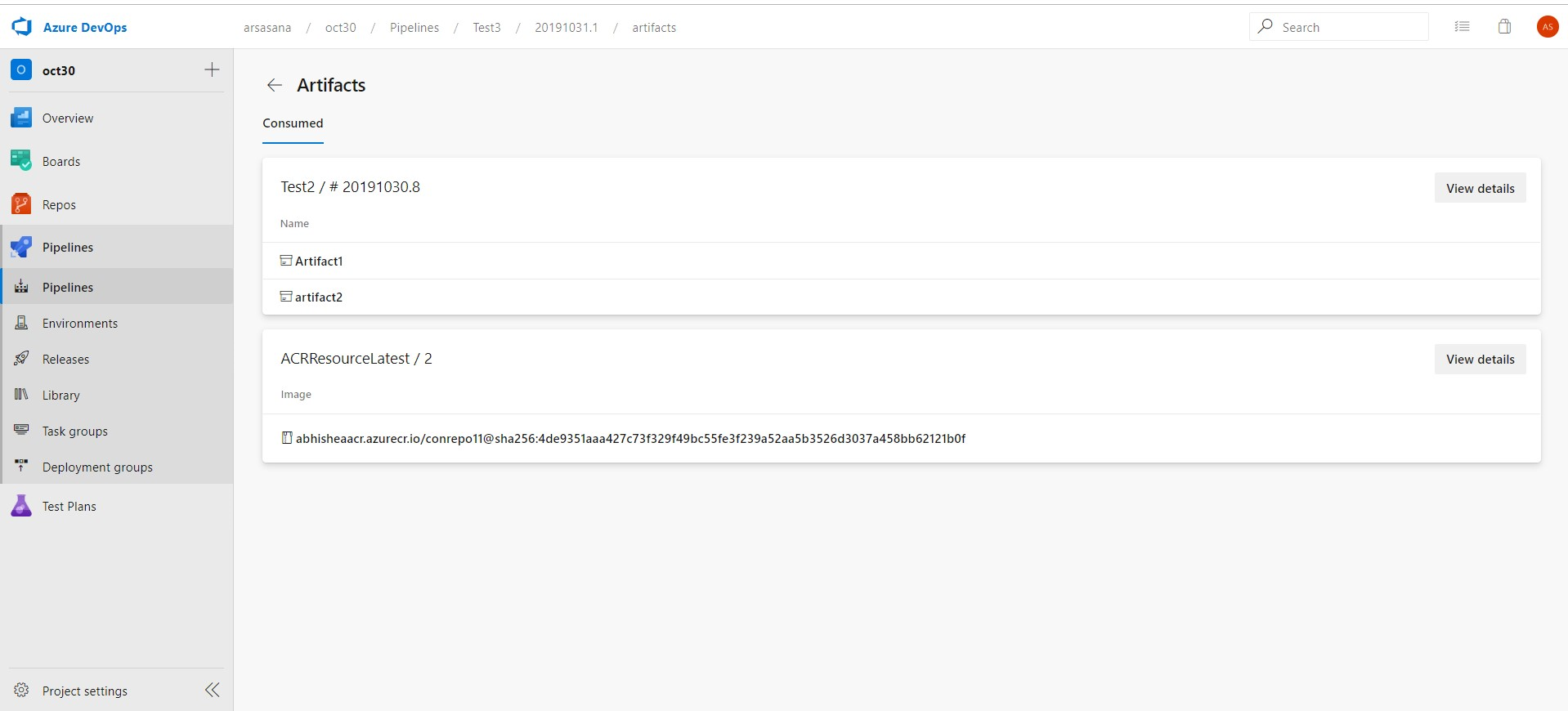
In the environment's deployments view, you can see the commits and work items for each resource deployed to the environment.

Simplified resource authorization in YAML pipelines
A resource is anything used by a pipeline that is outside the pipeline. Resources must be authorized before they can be used. Previously, when using unauthorized resources in a YAML pipeline, it failed with a resource authorization error. You had to authorize the resources from the summary page of the failed run. In addition, the pipeline failed if it was using a variable that referenced an unauthorized resource.
We are now making it easier to manage resource authorizations. Instead of failing the run, the run will wait for permissions on the resources at the start of the stage consuming the resource. A resource owner can view the pipeline and authorize the resource from the Security page.
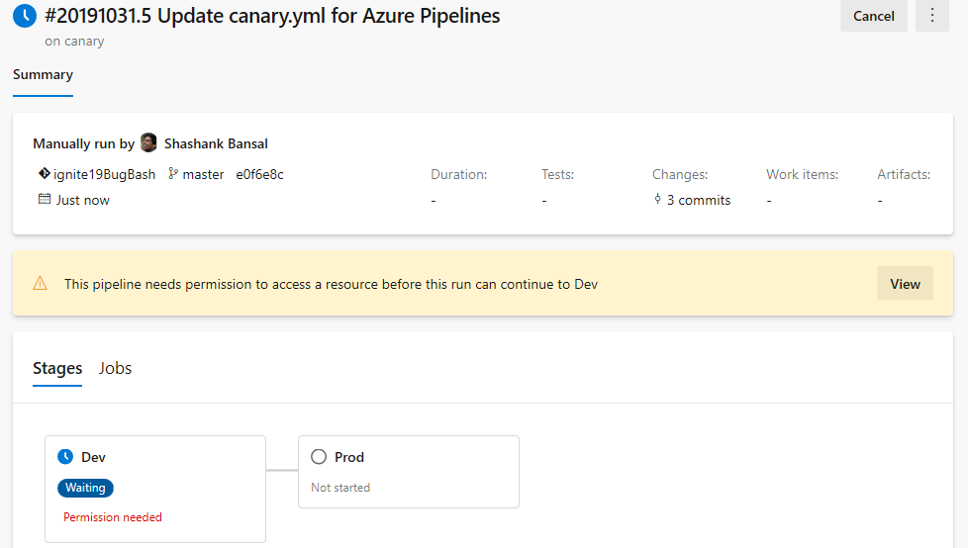
Improve pipeline security by restricting the scope of access tokens
Every job that runs in Azure Pipelines gets an access token. The access token is used by the tasks and by your scripts to call back into Azure DevOps. For example, we use the access token to get source code, upload logs, test results, artifacts, or to make REST calls into Azure DevOps. A new access token is generated for each job, and it expires once the job completes. With this update, we added the following enhancements.
Prevent the token from accessing resources outside a team project
Until now, the default scope of all pipelines was the team project collection. You could change the scope to be the team project in classic build pipelines. However, you did not have that control for classic release or YAML pipelines. With this update we are introducing an organization setting to force every job to get a project-scoped token no matter what is configured in the pipeline. We also added the setting at the project level. Now, every new project and organization that you create will automatically have this setting turned on.
Note
The organization setting overrides the project setting.
Turning this setting on in existing projects and organizations may cause certain pipelines to fail if your pipelines access resources that are outside the team project using access tokens. To mitigate pipeline failures, you can explicitly grant Project Build Service Account access to the desired resource. We strongly recommend that you turn on these security settings.
Remove certain permissions for the access token
By default, we grant a number of permissions to the access token, one of this permission is Queue builds. With this update, we removed this permission to the access token. If your pipelines need this permission, you can explicitly grant it to the Project Build Service Account or Project Collection Build Service Account depending on the token that you use.
Evaluate artifact check
You can now define a set of policies and add the policy evaluation as a check on an environment for container image artifacts. When a pipeline runs, the execution pauses before starting a stage that uses the environment. The specified policy is evaluated against the available metadata for the image being deployed. The check passes when the policy is successful and marks the stage as failed if the check fails.
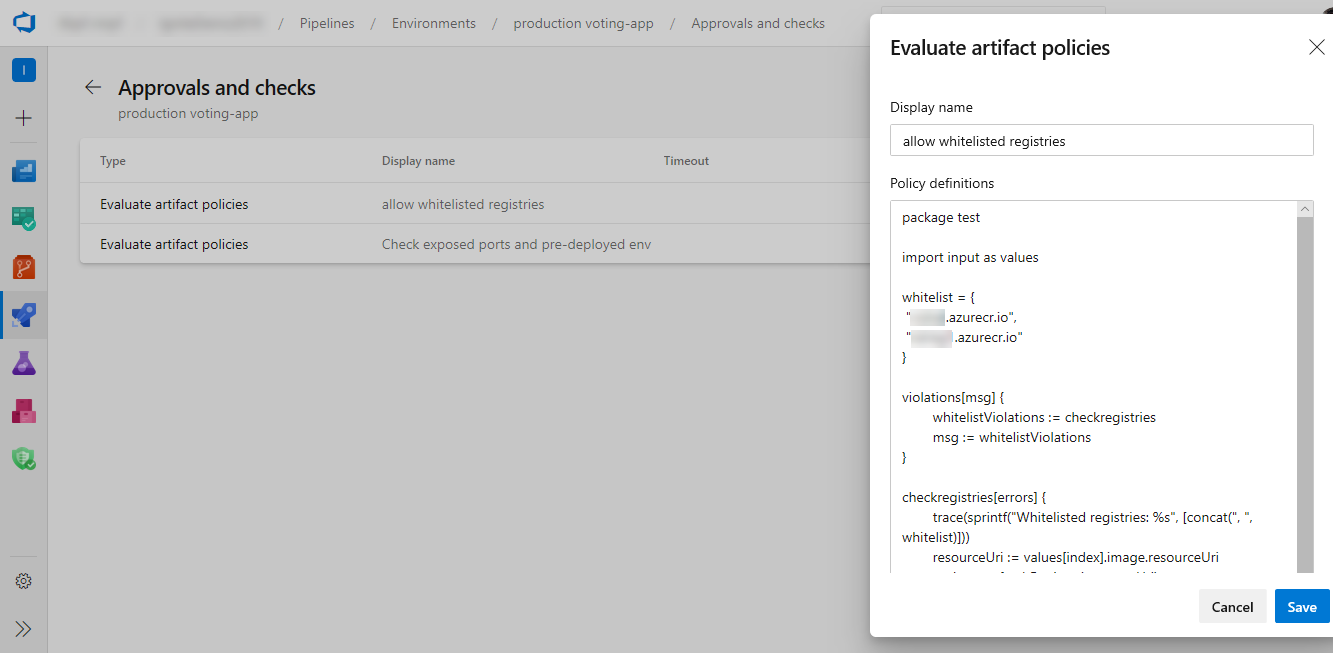
Markdown support in automated test error messages
We now support Markdown in error messages for automated tests. You can easily format error messages for both test run and test result to improve readability and ease troubleshooting the failure in Azure Pipelines. The supported Markdown syntax can be found here.

Diagnosing cron schedules in YAML
We have seen a steady increase in the use of cron syntax for specifying schedules in your YAML pipelines. As we listened to your feedback, we heard that it was hard for you to determine whether Azure Pipelines had processed your syntax correctly. Previously, you would have to wait for the actual time of the scheduled run to debug schedule problems. To help you diagnose branch/syntax errors, we added a new action menu for pipeline. The Scheduled runs in the Run pipeline menu will give you a preview of the upcoming few scheduled runs for your pipeline to help you diagnose errors with your cron schedules.
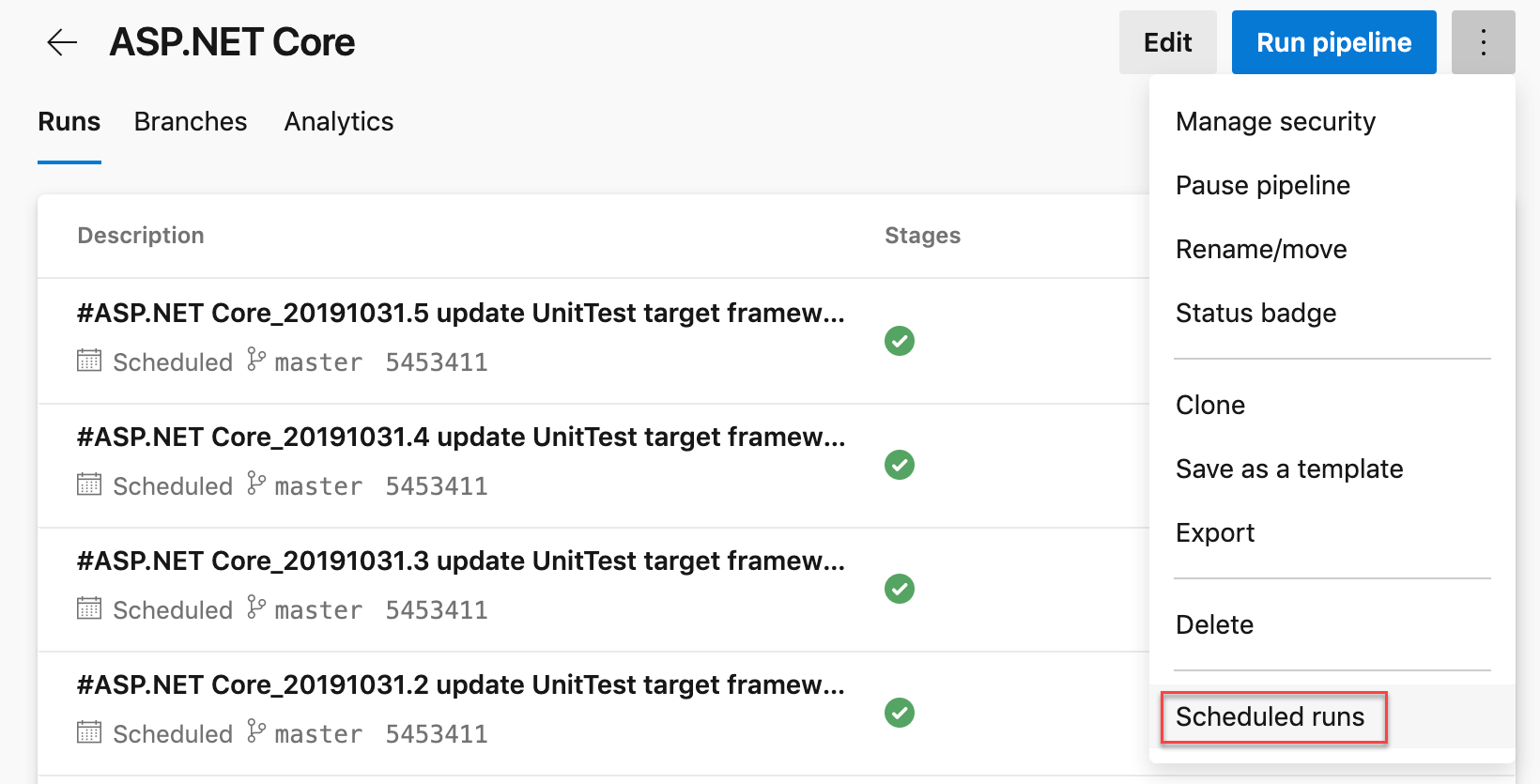
Updates to the ARM template deployment task
Previously, we didn't filter the service connections in the ARM template deployment task. This may result in the deployment to fail if you are selecting a lower scope service connection to perform ARM template deployments to a broader scope. Now, we added filtering of service connections to filter out lower scoped service connections based on the deployment scope you choose.
Project level security for service connections
With this update, we added hub level security for service connections. Now, you can add/remove users, assign roles and manage access in a centralized place for all the service connections.

Ubuntu 18.04 pool
Azure Pipelines now supports running your jobs on Ubuntu 18.04. We updated the Microsoft-hosted Azure Pipelines pool to include the Ubuntu-18.04 image. Now, when you reference ubuntu-latest pool in your YAML pipelines, it will mean ubuntu-18.04 and not ubuntu-16.04. You can still target 16.04 images in your jobs by using ubuntu-16.04 explicitly.
Service Mesh Interface based canary deployments in KubernetesManifest task
Previously when canary strategy was specified in the KubernetesManifest task, the task would create baseline and canary workloads whose replicas equaled a percentage of the replicas used for stable workloads. This was not exactly the same as splitting traffic up to the desired percentage at the request level. To tackle this, we've added support for Service Mesh Interface based canary deployments to the KubernetesManifest task.
Service Mesh Interface abstraction allows for plug-and-play configuration with service mesh providers such as Linkerd and Istio. Now the KubernetesManifest task takes away the hard work of mapping SMI's TrafficSplit objects to the stable, baseline and canary services during the lifecycle of the deployment strategy. The desired percentage split of traffic between stable, baseline and canary are more accurate as the percentage traffic split is controlled on the requests in the service mesh plane.
The following is a sample of performing SMI based canary deployments in a rolling manner.
- deployment: Deployment
displayName: Deployment
pool:
vmImage: $(vmImage)
environment: ignite.smi
strategy:
canary:
increments: [25, 50]
preDeploy:
steps:
- task: KubernetesManifest@0
displayName: Create/update secret
inputs:
action: createSecret
namespace: smi
secretName: $(secretName)
dockerRegistryEndpoint: $(dockerRegistryServiceConnection)
deploy:
steps:
- checkout: self
- task: KubernetesManifest@0
displayName: Deploy canary
inputs:
action: $(strategy.action)
namespace: smi
strategy: $(strategy.name)
trafficSplitMethod: smi
percentage: $(strategy.increment)
baselineAndCanaryReplicas: 1
manifests: |
manifests/deployment.yml
manifests/service.yml
imagePullSecrets: $(secretName)
containers: '$(containerRegistry)/$(imageRepository):$(Build.BuildId)'
postRouteTraffic:
pool: server
steps:
- task: Delay@1
inputs:
delayForMinutes: '2'
ReviewApp in Environment
ReviewApp deploys every pull request from your Git repository to a dynamic environment resource. Reviewers can see how those changes look as well as work with other dependent services before they’re merged into the main branch and deployed to production. This will make it easy for you to create and manage reviewApp resources and benefit from all the traceability and diagnosis capability of the environment features. By using the reviewApp keyword, you can create a clone of a resource (dynamically create a new resource based on an existing resource in an environment) and add the new resource to the environment.
The following is a sample YAML snippet of using reviewApp under environments.
jobs:
- deployment:
environment:
name: smarthotel-dev
resourceName: $(System.PullRequest.PullRequestId)
pool:
name: 'ubuntu-latest'
strategy:
runOnce:
pre-deploy:
steps:
- reviewApp: MainNamespace
Azure Artifacts
Updated Connect to feed experience
The Connect to feed dialog is the entryway to using Azure Artifacts; it contains information on how to configure clients and repositories to push and pull packages from feeds in Azure DevOps. We've updated the dialog to add detailed set-up information and expanded the tools we give instructions for.
Public feeds are now generally available with upstream support
The public preview of public feeds has received great adoption and feedback. In this update, we extended additional features to general availability. Now, you can set a public feed as an upstream source from a private feed. You can keep your config files simple by being able to upstream both to and from private and project-scoped feeds.
Create project-scoped feeds from the portal
When we released public feeds, we also released project-scoped feeds. Until now, project-scoped feeds could be created via REST APIs or by creating a public feed and then turning the project private. Now, you can create project-scoped feeds directly in the portal from any project if you have the required permissions. You can also see which feeds are project and which are organization-scoped in the feed picker.
Reporting
A Sprint Burndown widget with everything you've been asking for
The new Sprint Burndown widget supports burning down by Story Points, count of Tasks, or by summing custom fields. You can even create a sprint burndown for Features or Epics. The widget displays average burndown, % complete, and scope increase. You can configure the team, letting you display sprint burndowns for multiple teams on the same dashboard. With all this great information to display, we let you resize it up to 10x10 on the dashboard.
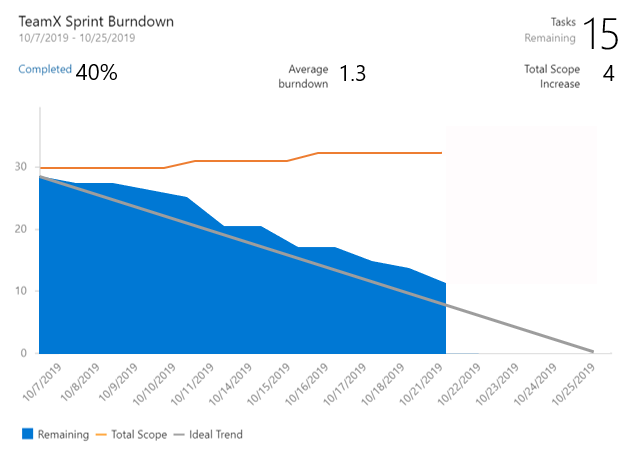
To try it out, you can add it from the widget catalog, or by editing the configuration for the existing Sprint Burndown widget and checking the Try the new version now box.
Note
The new widget uses Analytics. We kept the legacy Sprint Burndown in case you don't have access to Analytics.
Wiki
Synchronous scroll for editing wiki pages
Editing wiki pages is now easier with synchronous scroll between the edit and the preview pane. Scrolling on one side will automatically scroll the other side to map the corresponding sections. You can disable the synchronous scroll with the toggle button.

Note
The state of the synchronous scroll toggle is saved per user and organization.
Page visits for wiki pages
You can now get insights into the page visits for wiki pages. The REST API let you access the page visits information in the last 30 days. You can use this data to create reports for your wiki pages. In addition, you can store this data in your data source and create dashboards to get specific insights like top-n most viewed pages.
You will also see an aggregated page visits count for the last 30 days in every page.
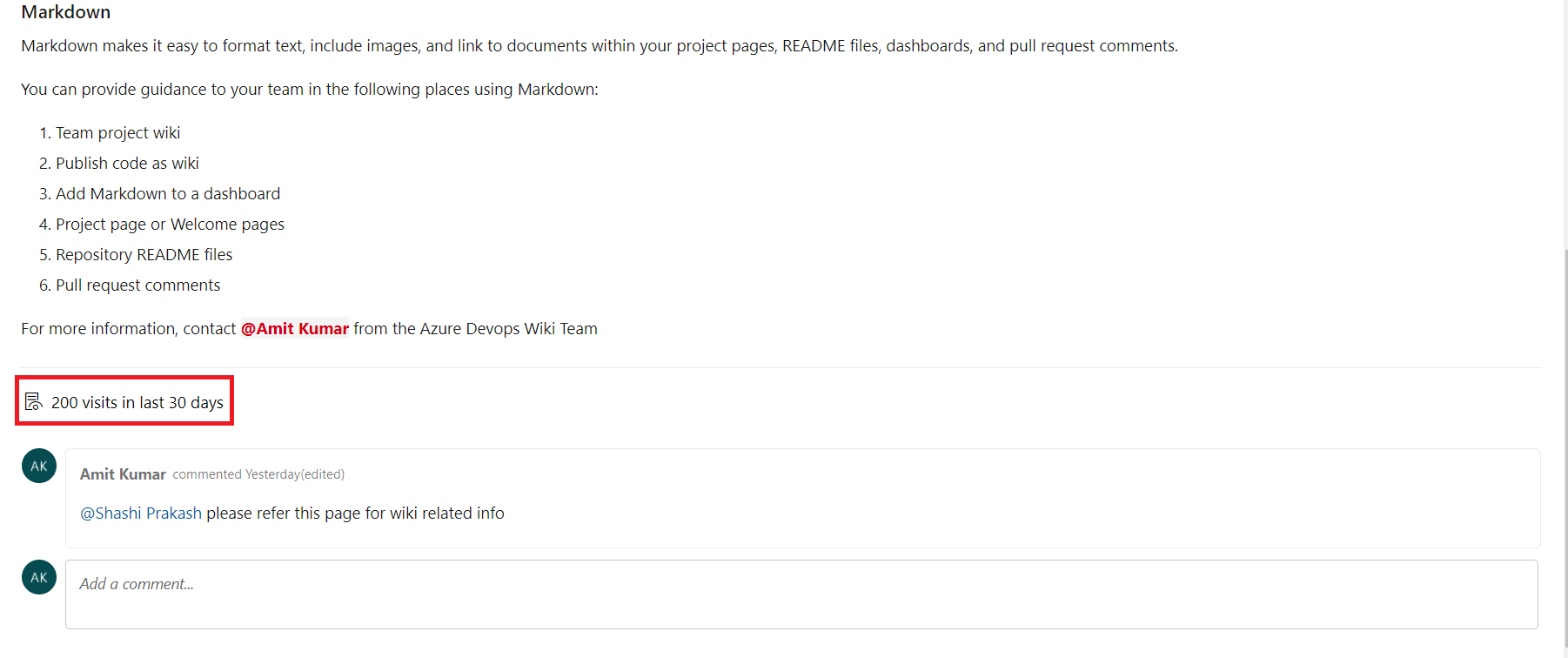
Note
A page visit is defined as a page view by a given user in a 15-minute interval.
Next steps
Note
These features will roll out over the next two to three weeks.
Head over to Azure DevOps and take a look.
How to provide feedback
We would love to hear what you think about these features. Use the help menu to report a problem or provide a suggestion.

You can also get advice and your questions answered by the community on Stack Overflow.
Thanks,
Jeff Beehler